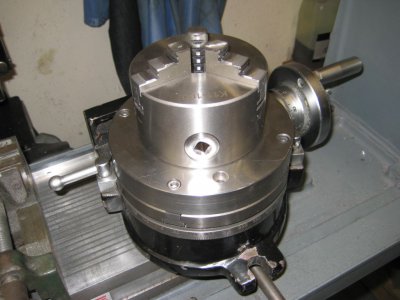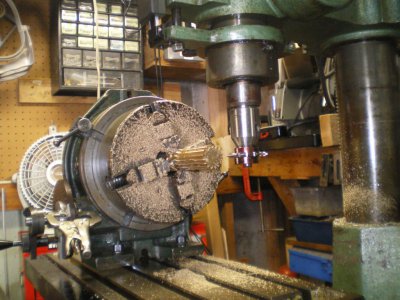I need some suggestions on mounting a 6” independent 4 jaw chuck on my 6” rotary table.
At the present time I made an adapter plate for my existing 8” 4 jaw lathe chuck. I used a ½”thick stainless steel plate. I threaded a MT 2 adapter to the center of the plate, the MT 2 fits into the bore of the table. The plate has 3 holes that correspond to the mounting pins of the chuck. I remove the camlock pins from the chuck and attach the plate. A couple of draw backs of this arrangement is that I lose the thru hole of the rotary table, the chuck is a little too large for the table, when using the table in the horizontal configuration the MT 2 adapter has come loose. I’m not happy with the rigidity this setup gives me. I need to purchase a 6” 4 jaw chuck just for the rotary table.
My one thought is to drill 4 holes thru the face of a 6” chuck, near the outer circumference, between the jaws, thereby allowing me to bolt the chuck directly to the table with T nuts in the 4 table slots.
My concerns are, is there any mechanism inside the chuck that would prevent these mounting holes, also I’m thinking the chuck is probably case hardened, which would create problems in drilling. I haven’t purchased a chuck as of yet, I have to figure out the mounting first, so this approach is till only a thought.
Has anyone done something similar, or have any suggestions on how to accomplish this?
At the present time I made an adapter plate for my existing 8” 4 jaw lathe chuck. I used a ½”thick stainless steel plate. I threaded a MT 2 adapter to the center of the plate, the MT 2 fits into the bore of the table. The plate has 3 holes that correspond to the mounting pins of the chuck. I remove the camlock pins from the chuck and attach the plate. A couple of draw backs of this arrangement is that I lose the thru hole of the rotary table, the chuck is a little too large for the table, when using the table in the horizontal configuration the MT 2 adapter has come loose. I’m not happy with the rigidity this setup gives me. I need to purchase a 6” 4 jaw chuck just for the rotary table.
My one thought is to drill 4 holes thru the face of a 6” chuck, near the outer circumference, between the jaws, thereby allowing me to bolt the chuck directly to the table with T nuts in the 4 table slots.
My concerns are, is there any mechanism inside the chuck that would prevent these mounting holes, also I’m thinking the chuck is probably case hardened, which would create problems in drilling. I haven’t purchased a chuck as of yet, I have to figure out the mounting first, so this approach is till only a thought.
Has anyone done something similar, or have any suggestions on how to accomplish this?


